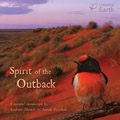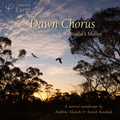

Running Time:
76 min
Release Date:
December 2016
Recording Location:
Olive Downs, Sturt Desert, far northwest NSW
If you like this album,
we also recommend:
Honeyeaters Sing in an Outback Dawn
This recording brings you a complete dawn chorus from the Sturt Desert in Australia's outback, from predawn to sunrise. Despite the arid conditions, this location is rich with diversity, and the dawn birdsong particularly spectacular.
As you listen, imagine a dry creek bed a few hundred metres before you, lined by stately old gum trees. Sandy tributary creeklines run to it, and it is by one of these dry swathes that we await the dawn. Around us are mulga shrubs and a community of flowering eremophilas (emu bushes). This combination of shelter and food has attracted numerous honeyeaters and other birds. Surrounding this relatively foliaged area, and stretching away behind, are bare, open, stony plains known as gibber country, which itself is home to hardier species such as blue and white fairy-wrens and spotted nightjars.
In the darkness before dawn, magpies give their nocturnal songs lazily, acoustically locating those old gum trees and the main creekline in the landscape. Other voices are also responding to the paling light along the eastern horizon; red-capped robins and variegated fairy-wrens.
From a nearby low shrub, a single white-fronted honeyeater begins calling; a rhythmical sequence of percussive and twangy outbursts. Meanwhile spiney-cheeked honeyeaters give rich, toneful songs. (These songs vary across the country, and so we are hearing the local dialect of this community of 'spineys').
After a while, a second white-fronted honeyeater joins in, alternating his calls with the first bird in a phenomenon called countersinging. They create dynamic back-and-forth cadences of rhythmic complexity, their voices riccocheting across the landscape.
As the light grows, other species join the swelling dawn chorus, notably the thin whistles of black honeyeaters. These small birds with long, downcurved bills are nectar specialists, and highly nomadic in search of stands of flowering shrubs. Their simple calls are easy to overlook, but very pleasant in chorus.
Eventually, activity wanes as the dawn chorus concludes, and birds move off to feed. By now the sun is on the horizon, and the desert light is a burnished gold.
Andrew comments:
"I stayed at this area for over a week, gradually immersing myself in the subtleties of the landscape, and finding out where birds were congregating and singing. I wanted to capture those wonderful white-fronted honeyeater calling patterns, plus the delicate songs of robins, black honeyeaters and fairy-wrens, without being overwhelmed by the louder spineys. It took me a while to find exactly the right spot for the microphones to balance out the various voices in the landscape. After numerous attempts, I found there was only one optimal 'listening spot'!
"The black honeyeaters in particular were a great delight to encounter, as they move around the outback irregularly in search of nectar, and every morning I was wondering whether they would still be around to contribute their lovely songs. Another highlight was a spotted nightjar, a night bird which can be heard giving its last calls before settling down nearby on open ground to roost for the day.
"It is a white-fronted honeyeater that features on the cover art."
Audio sample of this album
|
1. |
The Early Dawn: Magpies, Fairy-wrens & Spiney-cheeked Honeyeaters |
7.58 |
|
2. |
The First White-fronted Honeyeater Begins |
11.18 |
|
3. |
Antiphonal Singing from a Second White-fronted Honeyeater |
14.17 |
|
4. |
Black Honeyeaters & Crested Bellbird |
11.10 |
|
5. |
The Late Dawn Chorus |
31.35 |
Purchase this
album as:
Digital Album
(for immediate download)
Download this album
for as little as
$7.50 -
View Special Deals
(Prices AU$, exGST)
Mp3:
Mp3 is a universal audio format, playable on iPods, computers, media players and mobile phones.
Mp3 is a compressed format, allowing smaller filesizes, offering faster download times and requiring less storage space on players, but at some expense to the audio quality. Many listeners can't really hear the difference between mp3 and full CD-quality audio, and hence its convenience has lead to it becoming the default option for audio.
Our albums are generally encoded at around 256kbps (sometimes with VBR), balancing optimal audio quality without blowing out filesizes excessively. We encode using the Fraunhoffer algorithm, which preserves more detail in the human audible range than the lame encoder.
Our mp3 files are free of any DRM (digital rights management), so you can transfer them to any of your media technology. You've paid for them, they're yours for your personal use without restriction.
Mp3 files can be burned to disc, either as an mp3 disc, or an audio CD after converting them to a standard audio (.wav or .aif) format first.
FLAC:
FLAC is a high-quality audio format, allowing CD-resolution audio. It is ideal if you wish to burn your files to a CDR, or listen over a high resolution audio system. However files usually require special decoding by the user before playing or burning to disc.
FLAC (Free Lossless Audio Codec) is a LOSSLESS compressed audio format. This means that it preserves the full audio quality of a CD, but optimises the filesize for downloading. Typically, file sizes of around 60% are achieved without any degradation or loss of audio quality from the source files at the CD standard of 16bit/44.1kHz.
Obviously the file sizes are larger than for the mp3 version - usually around 300-400Mb for an album, compared to 100Mb for an mp3 album.
In addition, you'll need to know what to do with the files once you've downloaded them. In most cases you'll want to decode the files to wav or aiff, either to import into programs like iTunes, or burn to CDR. Some programs will play flac files natively.
There is a lot of information about flac online (eg: http://flac.sourceforge.net/)




 Alternate audio link
Alternate audio link 